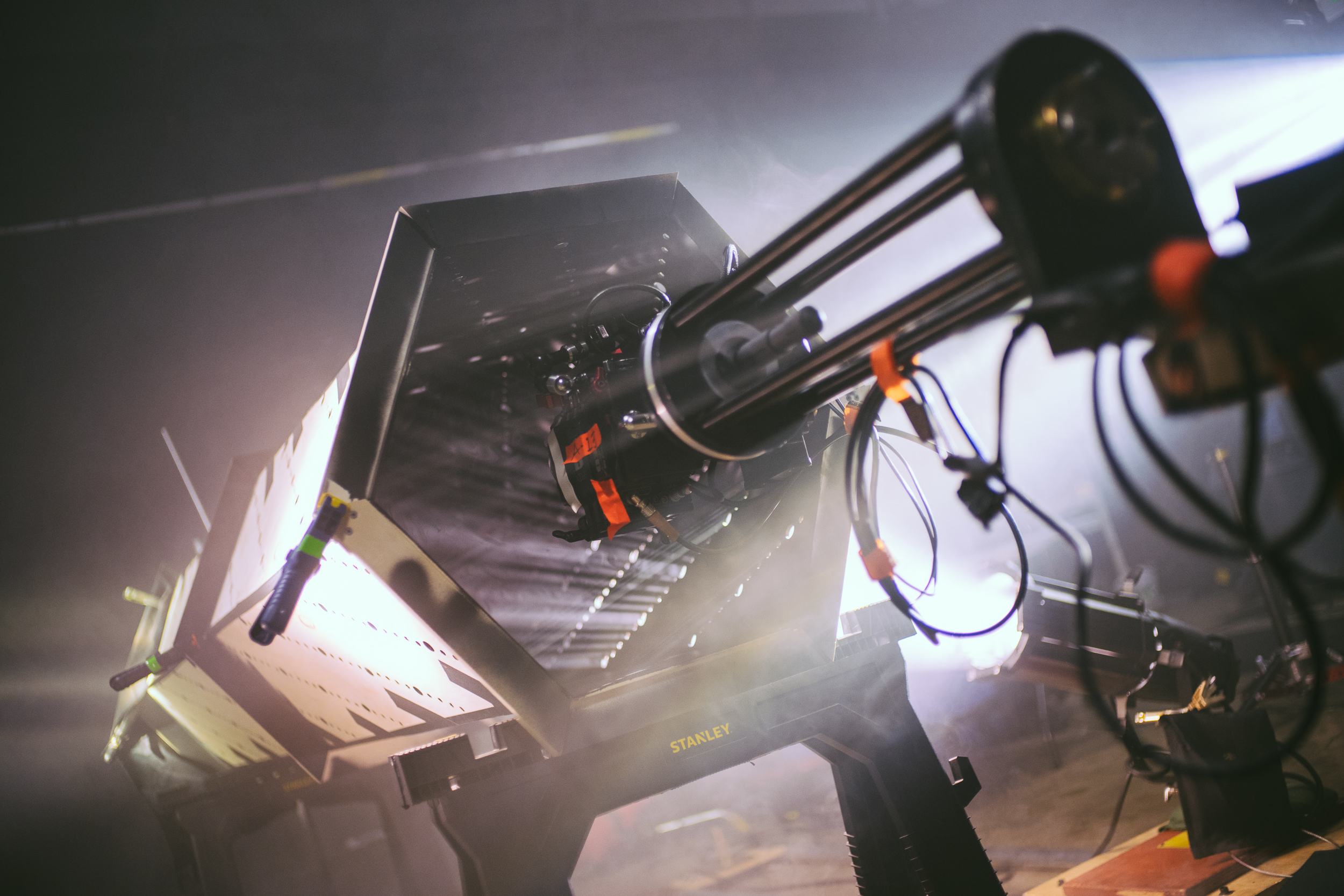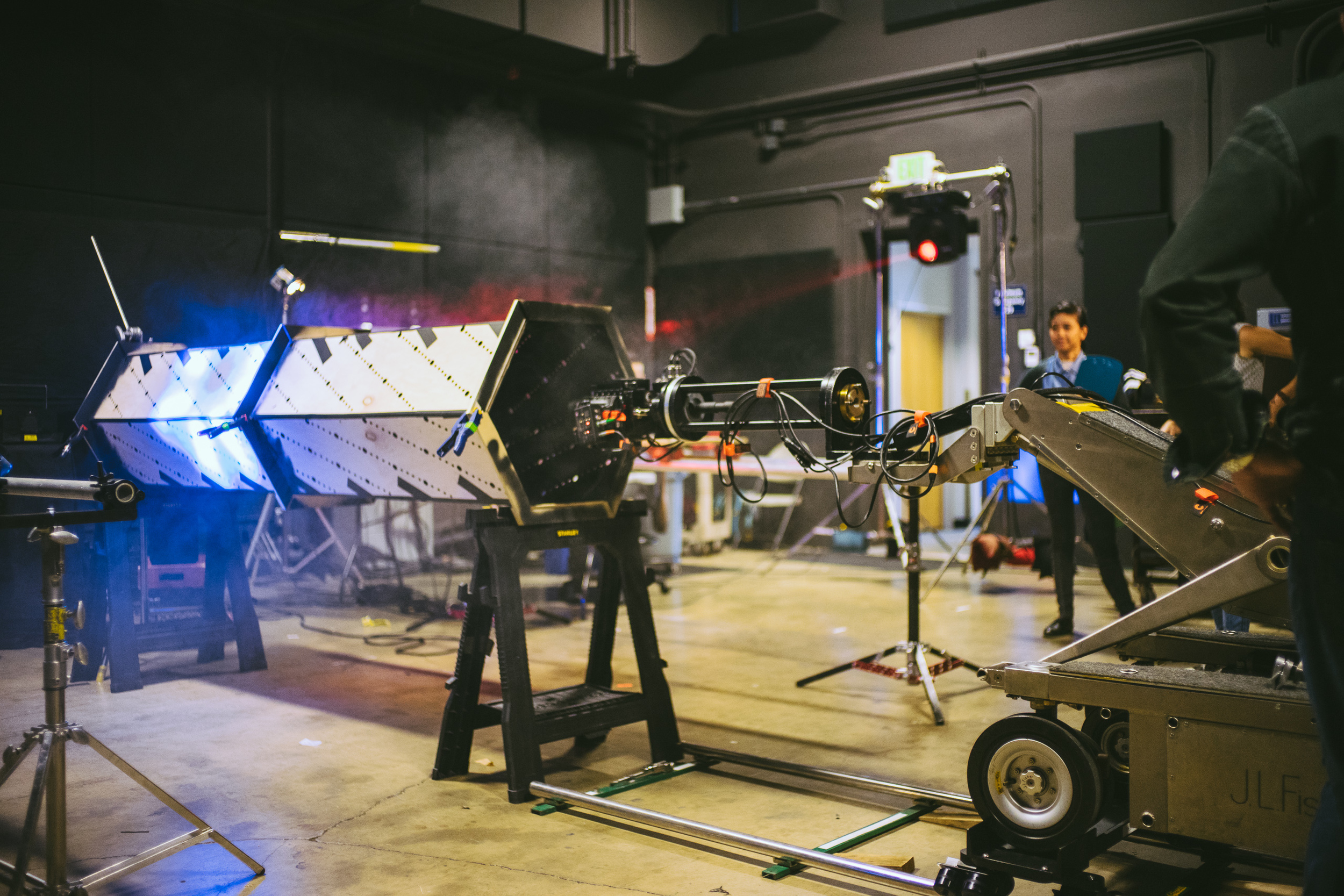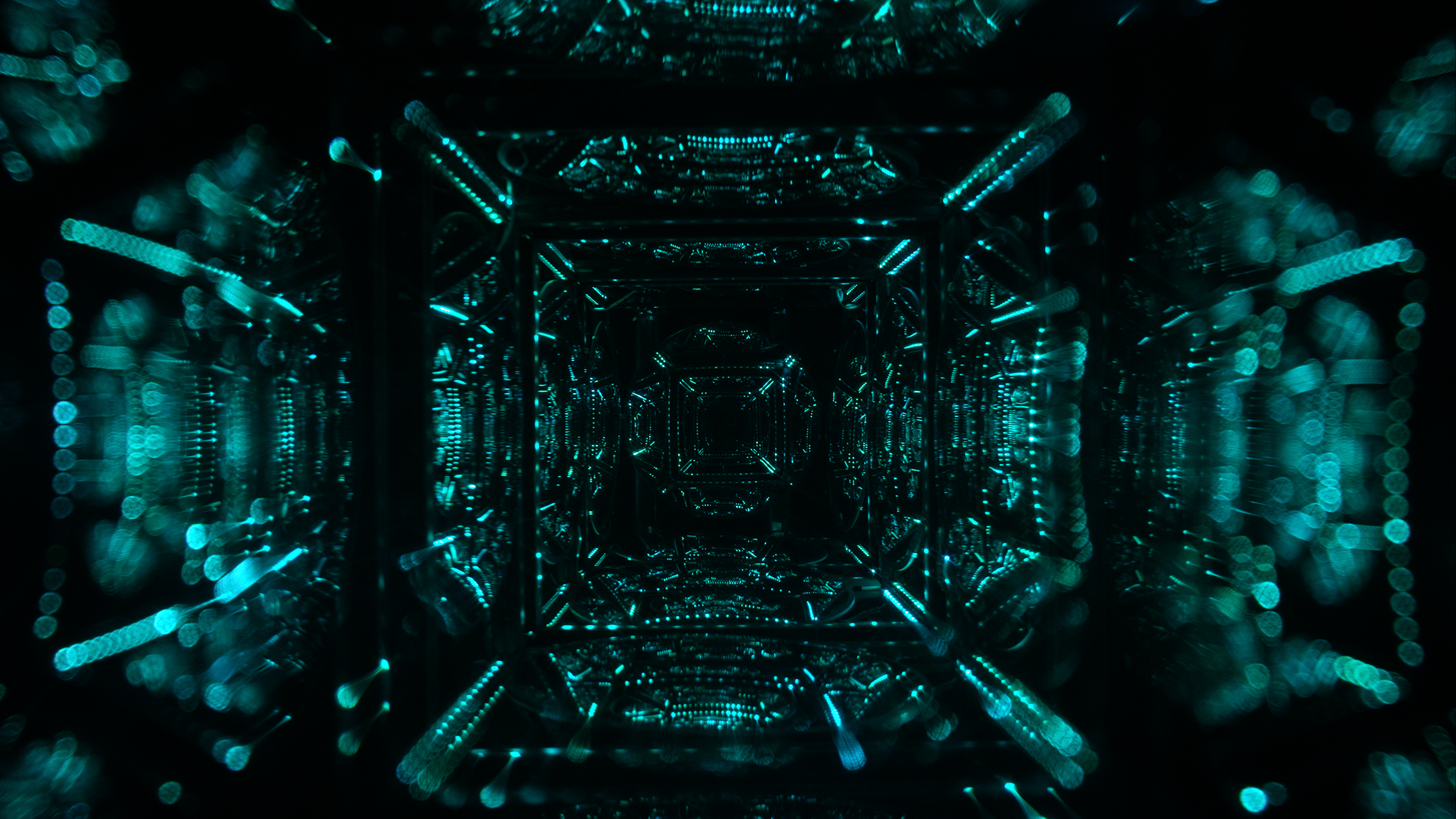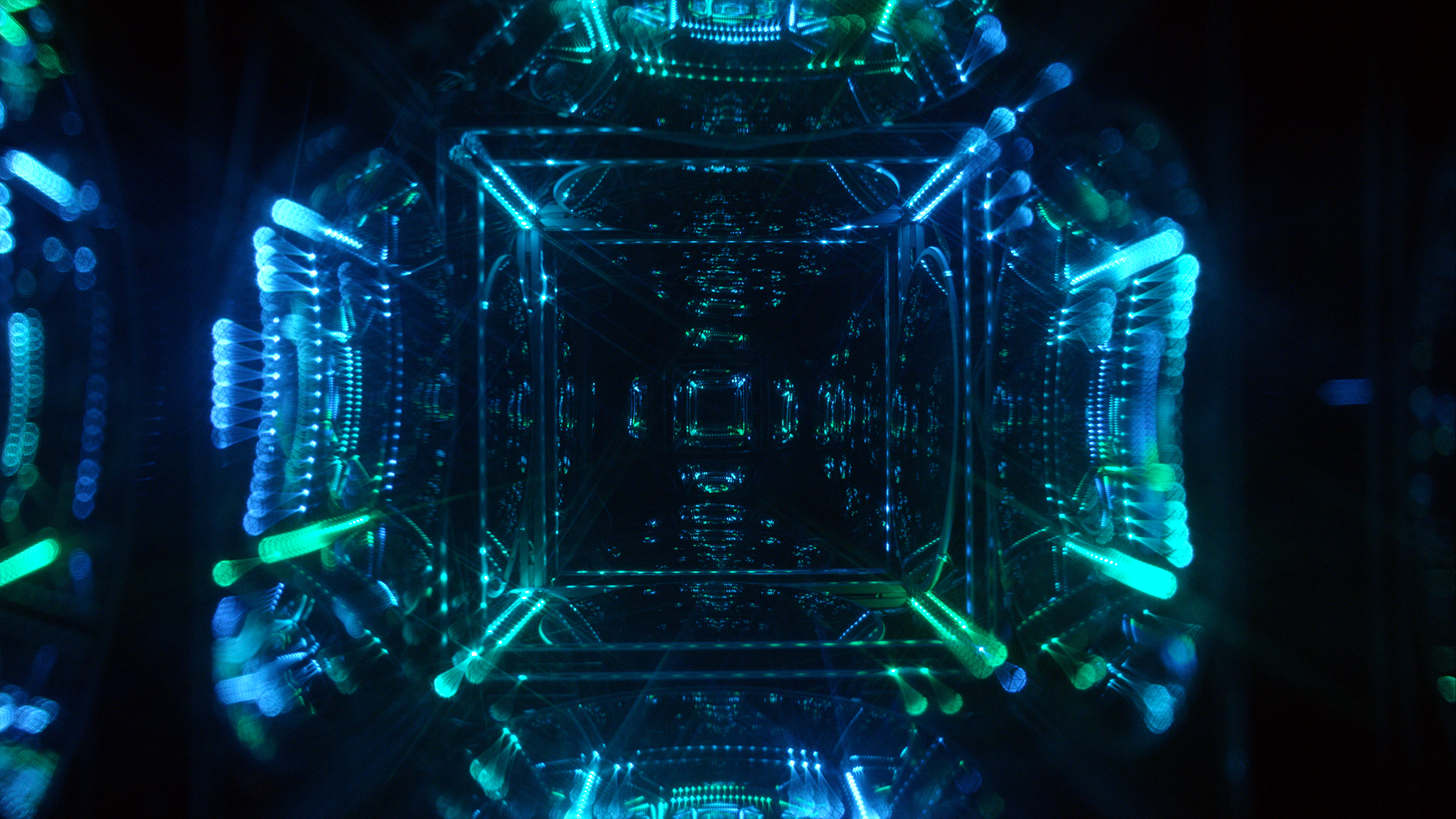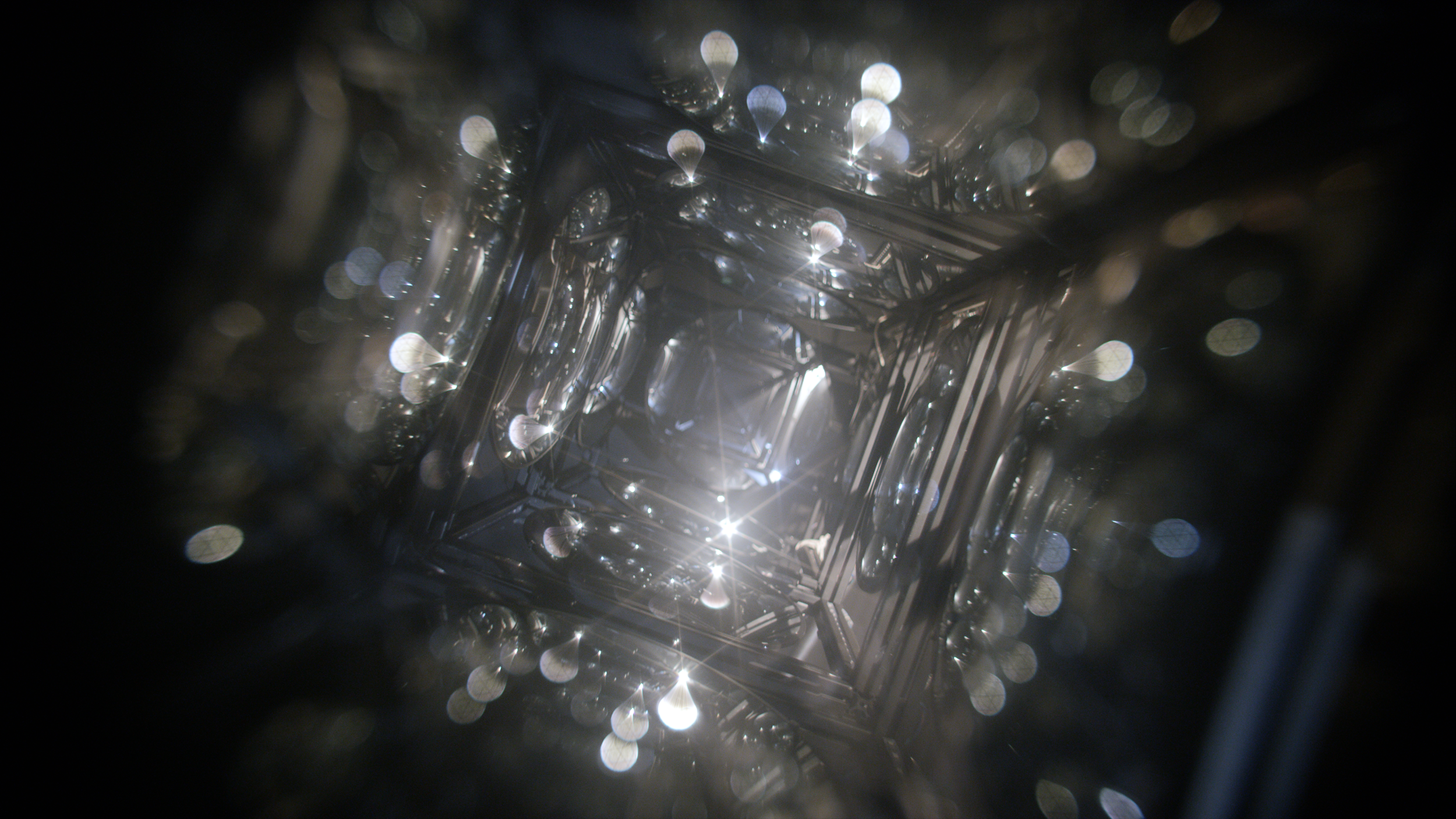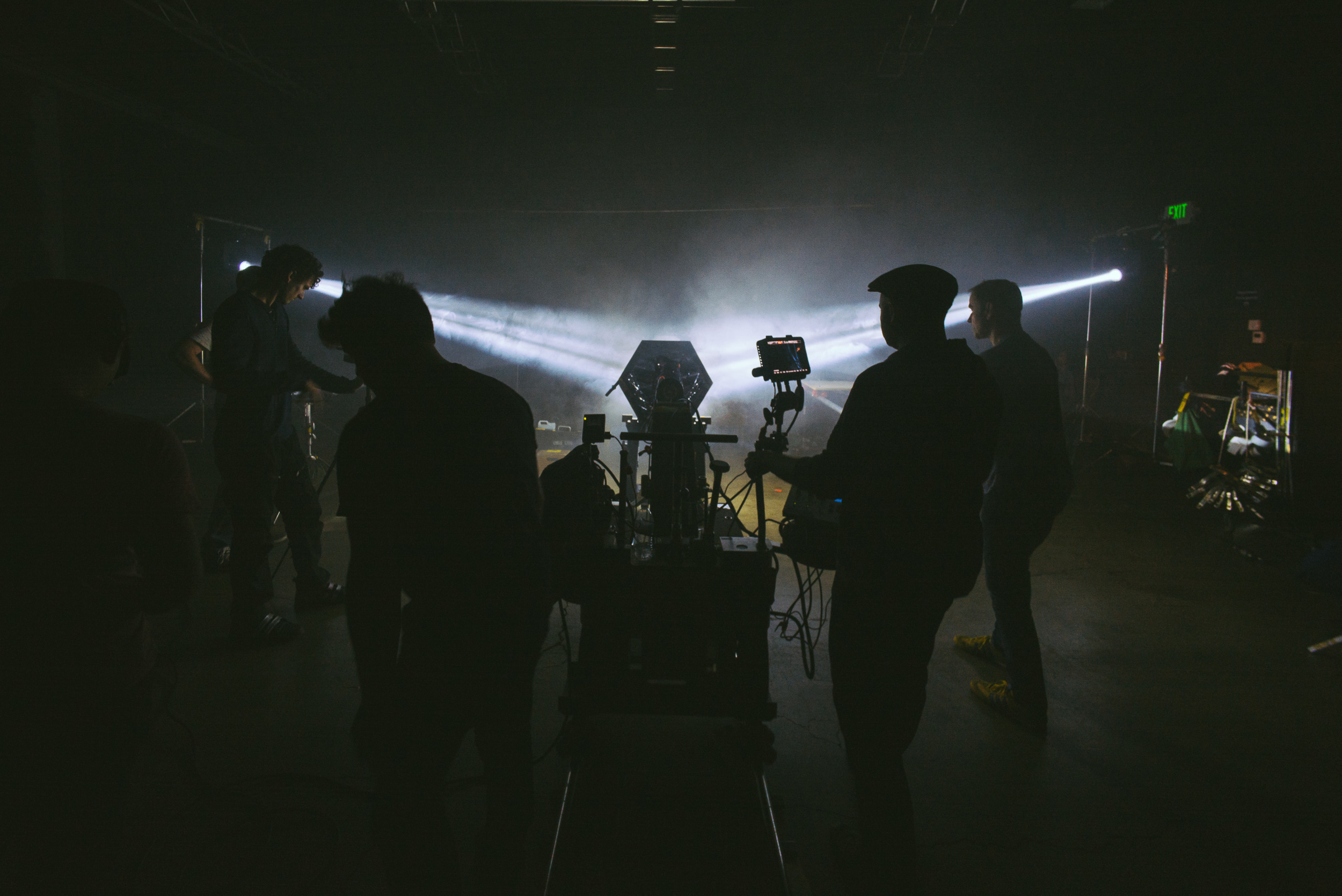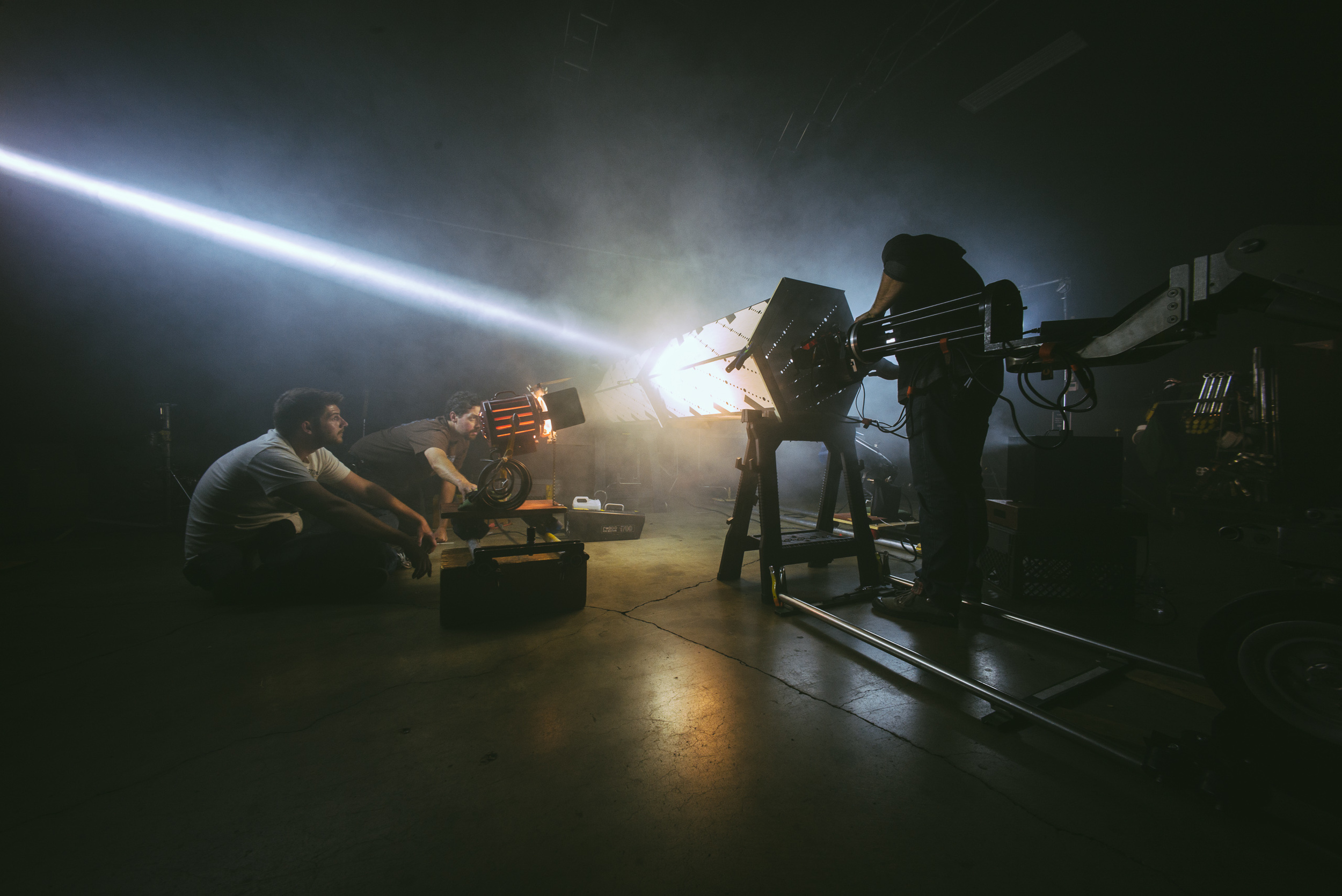The Film
Director: GMUNK
The journey focuses on the interaction between the beat of the music; incredible light set-ups that create a phantasmagoric visual world of illuminated shapes and pixels; and a whiff of humanity represented by a single Woman who experiences it all. We open with the most simplistic version of our light set-ups: a basic configuration of our standard sugar cubes, perforated light tunnel, and laser effects, which engage with the nascent beat as it begins. The pulse of the sugar cubes are synchronized to the music throughout, acting as a metronome; the song playing: a heart-beat thumping. Meanwhile, we introduce shots of a WOMAN’S EYES, the light reflecting in her irises. It’s a hint of humanity, as the beat of the song thumps in tandem with the lights — a living, breathing pulse.
As the song builds, the lights become more dynamic, our Woman’s eyes interacting psychedelically with the lights as her perception distorts along with them. We introduce convex mirror tubes with LED light shooting through, adding to the energy being generated by the sound of the music. We see a few other shreds of our Woman as well; light moving over the back of her neck, eyelashes in silhouette; just enough to give a taste of a human presence amidst this technologic pulse of energy.
Fisheye shots and tunnels of disembodied glowing light move toward, past, and through the camera creating an undulating tapestry of visual madness as the beat breaks, bringing us to the peak of the song where we reveal the Queen Bee of light: a round, ripe, pulsating light sphere that seems electric and otherworldly in its power. Created in combination by filling a transparent half-dome with smoke, and lit so that it seems to glow, white-hot and electric, taking on a life of its own as the music moves towards suspension.
As this incredible sphere of light overtakes the frame, our Woman’s face is fully revealed, basking in the charged energy of the music, light, and smoke. Meanwhile, our visuals peak, spilling over into new depths of intensity as we switch to a prism lens and optical filters. Geometric lines blast through our mirror tube as lasers bounce through it — gradient filters create a surrealist color palette— our prism lens creates an ultra distorted image, showing us our Woman’s face and eyes multiplied in a honeycomb of images, the power of light and sounds now at her fingertips. It’s a feast of light, shapes, and warped visual perspectives that brings the music and lights memorably together.
Photographic Approach
Director of Photography: Joe Picard
Camera Rig
Most of the video was shot from within tubes. It was very important that the camera had dramatic motion to emphasize the pace of the song. The tubes were only about two feet in diameter making it hard to penetrate. A typical camera rig is too large. We needed a long and strong shaft to support the camera and be thrust in and out with rhythmic inspiration. We pulled this off both horizontally and vertically with a fisher 10 camera dolly, rigged with 4 feet of mitchell risers supporting a motion-control pan/tilt head. With the camera pointed straight up we were able to roll the camera on center adding tons of motion to the picture.
Hanging the Cubes
We decided to hang the sugar tubes from the grid, exposing the open end of the towers to the camera from below. This allowed us to boom the dolly straight up and down giving 4 feet of smooth hydraulic travel. The motion control camera head was stacked onto 4 feet of mitchel risers. Allowing the camera to travel the a narrow straight path upward. Hanging the sugar cubes also allowed us to cluster 9 towers closely together. With the motion control head we were able to smoothly pan and tilt the camera inside of the sugar cube abysse as the hydraulic column lifted and relaxed.
Optics
Once we had established a psychedelic world of led’s and straight linear perspective within the “Sugar Cubes” and “Perforated Tunnel” we wanted to bend the reality of it. We started working with a 180° circular lens. This lens distorts linear perspective into a flattened sphere. While it pushes through a sugar cubes tower the square form gets stretched to a circle on the edge of round frame just as the lens pushes through it. As the lens moves explores cubed geometry, linear perspective expands into circular rings.
We also played with some prismatic lens modifyers. These “multi-image” filters duplicated parts of the frame in a kaleidoscope like fashion. We also had a circular prism nicknamed “the cyclops” which created beautiful little flares around the leds and distorted the edges of the frame as well. Additionally we stacked and collection of star filters to enhance the sparkle of the leds.
Perforated Tunnel
The perforated tunnel is a plywood octagon tube with a hole pattern cut into it for light beams to stream in. We lit this with concert lighting, two Clay Paky Sharpys stroked the outside of the tunnel creating many moving shafts of light inside the tunnel. Adam Labay of Future Weapons created the stroking motion with his GrandMA system.
The fisher dolly was now rigged for horizontal probing with a two foot riser and the motion control head rigged horizontally. The whole thing was on dolly track so it could be manually pushed in and out while rolling and tilting the camera. As the lightning strokes penetrated the perforations, the camera would travel inward and outward in rhythm with the light. Just when the corybantic motion hit it’s highest Adam unleashed his laser, blasting down the tunnel just past the lens creating a transcendental portal into electro bliss.
The Practical Approach
Design Director: Conor Grebel, Mike Williams
Augmenting the Cubes with Convex Mirrors
We knew we wanted to build some sort of practical tunnel the camera could travel through to match the driving feeling of the track. Ever since I saw Interstellar my mind has been flooded with film SFX concepts involving bending light and curved mirrors, at my house I have a small collection of convex / concave mirrors laying around. The opportunity to use them has been a long time coming. So for a solid week we bounced around some concepts involving tunnels of curved mirrors. It plays off of the infinity mirror trick, but when using curved mirrors the endless internal reflections bend into tendrils of fractal shapes.
It all changed when we mocked what it would look like if we had strips of color changing LED’s running inside the mirror tunnel. The Sugar Cubes were a great asset, a geniously modular piece of hardware that can run endless live patterns through any configuration you put them in. It was a magic combination. We could only hope that our previz in 3D looked as amazing in person...luckily it exceeded expectation. To be perfectly honest I’ve never felt my heart beat so hard while watching a live video feed. The endless maze of LED fractal patterns that reflected in the mirrors were so dense and exciting it nearly gave me an panic attack.
External Light sources and the Convex mirrors
The patterned LEDs from the cubes was thought of as the hero for this setup, but as it was a massive undertaking to rig up the structure...it's important to milk as much variety out of it as you can. To contrast the intensely detailed LED patterns, we came up with a simple setup that created a whole new look altogether. We turned off the LEDs and filled the studio with fog, used studio lights with gels to create calming volumetric beams entering from outside the tunnel. The lights silhouetted the shape of the rigging and mirrors, calling attention to the tunnel’s structure. We used a combination of warm and cool colors, slowly panning them in and out of vision. It was a really beautiful look, completely different than the LEDs.
Balls with Refraction
This concept was particularly satisfying, not only in its simplicity but because it was a physical manifestation of our digital work in 3D. We found these silicone balls at a craft store, when you soak them in water they become perfect little clear spheres with the same refraction index as water. In open air they act like perfect sphere lenses, a familiar tool in regards to creating optical refraction art in 3D. We lined the bottom of a glass bowl with a single layer of balls, and propped it on top of a display and ran a bunch of trippy / oppy textures. The outside of the glass bowl was lined with mylar because….when the opportunity to add even more sparkle and reflection arises, we jump on it. The whole rig acted like a giant compound eye, distorting and transforming the screen content beneath the bowl into a hundred tiny spheres.
Perforated Tunnel
The perf tunnel is essentially an 8 foot hexagonal tube, open on both ends, with a pattern of holes cut into the sides. It came out of the idea to use the magic and brilliance of volumetric light to create a surreal and overwhelming physical environment that evoked depth and motion. We started by running some tests in 3d, and went on to build several smaller prototypes out of peg-board, testing them with a small fog machine and hand held shop lights. Even with these crude materials, the test footage was impressive and we knew we were on to something. After a few more tests, we were ready to build the real thing...
For this we had the privilege of working with Kenny (last name??), an extremely talented carpenter and craftsman. He was super helpful and generous, and totally essential in bringing the design to life. With Kenny’s help, we carefully drilled (by hand!) a pattern of holes, alternating in size, into the walls of the tunnel along a spiraling path. When hit with lights and fog, the result was a stunning geometric matrix of intense light beams sweeping past the camera, as well as an intricate pattern of glowing points along the interior of the tunnel. This effect was made all the more dramatic by the sphere lenses, crazy optical filters, and expertly executed camera moves.
One very nice surprise that we had not anticipated in our early tests was the use of lasers inside the tunnel. That brought it to a whole new level of intensity! “Laser tunnel” was the last thing we shot and it was great to end on such an exciting and satisfying note.
The Technical Process
Sugar Cube Director: Alexander Green
The SugarCubes
The Cubes are a modular 3D LED installation that can be built, like legos, to form surfaces and shapes. They are designed to be a “light instrument”.The algorithms that run on them have a wide variety of parameters that can be tuned live to compliment music and achieve color and emotional palettes.
For the Generate video we used them in a few entirely new ways. We rigged them from the ceiling and used a camera equipped with a variety of lenses including a sphere lense that stretched the cube geometry semi-spherically. The motions of the camera through the structure gave us a variety of different effects as we manipulated the patterns running on the cubes to achieve aesthetics specifically for the video.
The second approach was even more involved and technical. 5 cubes were spray painted jet black and the LED strips were flipped to only face internally. Then 24 18’’ convex mirrors were placed in the open faces of the cubes.We used the cubes as a real-life fractal generator. This was a novel way to use the cubes, one that I never anticipated when I built the sculpture.
Credits
Production Company: Tool of North America
Production Dept.
Director: GMUNK
Managing Director Live-Action: Oliver Fuselier
Executive Producer: Robert Helphand
Head of Production: Amy Delossa
Producer: Yovel Schwartz
Production Supervisor: Johnny Carroll
Asst. Supervisor: Geoffrey Sawyer
Production Assistant: Hannah Burgos
Production Assistant: Josh Cereghino
Production Assistant: Tim Ditmer
Client: Virgin Records
Prydz Creative Director: Liam Tomaszewski
Virgin Creative Director: James Hackett
Camera Department
Director of Photography: Joe Picard
1st AC: Jeremy Wong
2nd AC: Dakota Wilder Smith
Script Supervisor: Stormy Pyeatte
Grip & Electric Department
Gaffer: Nick Anthony
Key Grip: Don Henderson
Grip: Patrick Walsh
Art Department
Design Director: Conor Grebel
Design Director: Mike Williams
Prop Master: Conor Grebel
Prop Master: Mike Williams
Sugar Cube Director: Alexander Green
Sugar Cube Technical Director: Trip Vest
Sugar Cube Programmer: Jake Lampack
Sugar Cube Programmer: Ben Morrow
Casting: Scout Model Agency
Woman: Terra Juano
Stylist: Lisa Zomer
Editing Facility: Final Cut LA
Editor: Arianna Tomasettig
Editorial Producer: Michael Miller
Post Facility: Spypost
Colorist: Carey Burens

















